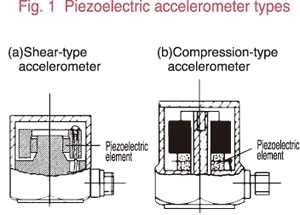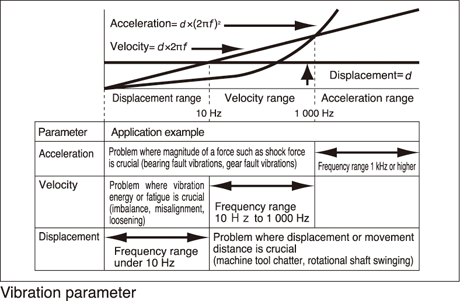VIBRATION AND VIBRATION METERS
Importance of Vibration Measurement
Normally, vibrations arising in an industrial or residential environment are clearly an unwanted phenomenon, except in some special cases. Such unwanted vibrations are not only unpleasant to humans but they can also shorten the life of machinery, impair product quality, and cause defects and breakdowns.
Sound arising from vibrations is also an environmental problem. Finding solutions to the multi-faceted problems presented by vibrations therefore is an important and pressing task.
RION vibration meters are effective tools used to collect information in a wide range of fields. These include the maintenance, monitoring and testing of machinery, product design and research, quality control, noise and vibration countermeasure research, evaluation of tools and vehicles according to labor environment and hygienic regulations, vibration pollution control, and seismographic data collection and disaster prevention.
How to Measure the Magnitude of Vibrations
There are three vibration parameters which can be used to express the magnitude of vibration: displacement, velocity, and cceleration. Which of these factors is used depends on the type of vibration and the measurement objective.
The relationship between them in the case of a sine wave vibration is shown in the illustration below.
Vibration Meters for Mechanical Vibrations
When vibration meters are used for measuring machine vibrations, a suitable accelerometer must be selected depending on the type of mechanical.
Accelerometers designed for low frequencies measure low acceleration levels and,thus, are highly sensitive. However, their larger size and mass result in low resonance frequency when mounted. Accelerometers for high frequency measure high
acceleration levels and are normally compact and lightweight with low sensitivity.
RION offers a selection of piezoelectric accelerometers, covering a wide frequency range. By combining an accelerometer with a vibration meter that is designed to make the best use of its characteristics, a wide range of measurements can be performed with optimum efficiency.
Piezoelectric accelerometers are normally used for measuring vibrations with a frequency of more than 1 Hz. This type of accelerometer has good high-frequency characteristics and is especially suited for measuring vibrations in the upper frequency range. Major applications are vibration monitoring and diagnostic checks of mechanical installations in industrial plants. Piezoelectric accelerometers generate a certain amount of low-frequency noise when ambient temperatures change (so-called pyronoise). Depending on the application, the accelerometers must therefore be protected from temperature changes. When velocity and displacement to be used for evaluation are obtained by integrating acceleration, pyronoise will to be evaluated as
integral products, pyronoise will be amplified and must therefore be given special consideration. With the exception of types containing, piezoelectric accelerometers require a charge amplifier.
What is the piezoelectric accelerometer?
Certain types of crystals will generate an electrical charge on their surface when mechanical distortion is applied. The amount of the charge is proportional to the external force given to the crystal.
This phenomenon is called the piezoelectric effect, and the piezoelectric accelerometer makes use of it. This accelerometer type can be made compact and lightweight, covering a wide vibration acceleration and vibration frequency range. Accuracy and reliability are also very good, and handling is simple. Thanks to these characteristics, piezoelectric accelerometers are widely used from on-site vibration measurements to a reference accelerometer.
There are two types of piezoelectric accelerometers which differ in the way the piezoelectric element is used. Figure 1 shows the two construction principles, namely a shear-type accelerometer and a compression-type accelerometer.

Shear-type pickup (accelerometer)
The accelerometer is constructed in such a way that the piezoelectric element is subjected to a shear force. Sensitivity is high, which allows for small dimensions. As shown in Figure 2.
pyronoise (pyroelectric output) caused by temperature changes is low, making it possible to measure low-level vibrations and vibrations in the low frequency range. This type is useful for monitoring vibrations in mechanical and buildings, and for seismometer applications.
Compression-type pickup (accelerometer)
This type of accelerometer employs a weight on top of the piezoelectric element. The structure is simple and mechanical strength high, making it suitable for high acceleration levels and shock measurements.
Measurement of Vibration Pollution (Vibration Level Meter)
The evaluation of vibrations considered as environmental pollution uses the vibration level (dB), which is based on the pattern of human sensitivity to vibration.
This is the same principle employed for the measurement and evaluation of sound pressure levels considered noise. Compensation according to human sensitivity characteristics is applied to the measured physical quantity (acceleration in the case of vibration pollution), and the resulting value forms the basis of evaluation.
The illustration below shows the frequency response that is stipulated by JIS C 1510 for vibration level meters.
Equipment Diagnosis
| ① Types of equipment maintenance |
Depending on the importance of the equipment, there are various kinds of maintenance,
required. In each case, the objective is to achieve maximum efficiency at minimum cost.
- Breakdown Maintenance (BM)
The principle here is to repair equipment when it breaks down.
- Time-Based Maintenance (TBM)
Parts are replaced at regular intervals regardless of breakdown and schedules are established for routine checks, disassembly and repairs. This is a kind of Preventive Maintenance (PM).
- Condition-Based Maintenance (CBM)
The operational condition of machinery is regularly leading to measured to determine the degree of deterioration or the existence of other factors equipment breakdown, Mechanical Checks, disassembly, repairs, and parts replacement are then carried out as a result.
This is a kind of predictive maintenance (PRM).
|
|---|
| ② Equipment diagnosis by vibration measurement |
The vibration method diagnosis by vibration measurement involves measuring vibrations of the equipment in operation for early detection of problems and taking optimum countermeasures. This is effective for key equipment directly linked to manufacturing facilities, particularly rotating (machines).
|
|---|
| ③ Frequency response on vibration parameter |
Depending on the vibration frequency, each amplitude response of displacement, velocity and acce
|
|---|
| ④ Diagnosis methods |
- Simple diagnosis
For this type of diagnosis, vibration measurements are carried out periodically by service personnel; The trend management of measurement results are then used for preventive maintenance of equipment.
Suitable products include VM-82, VM-63A, VA-12, etc.
- Precision diagnosis
Vibration signals are processed using FFT analysis or other similar techniques to identify problem areas and to initiate checks and repairs.
Suitable products include VA-12/11C, SA-78 etc.
|
|---|
